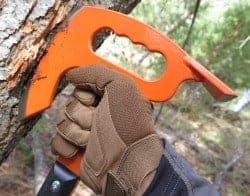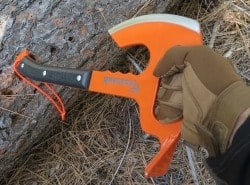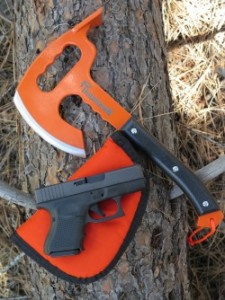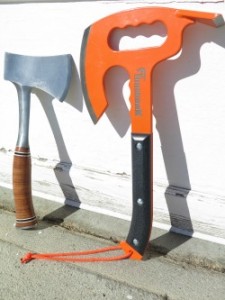Few things turn on a survivalist like a new piece of kit that has tremendous potential. And two of them just landed in my bug out loadout. Cutting to the chase, they are Timahawks. ‘Timahawk’, you ask? Yes Tim-a-Hawk. The designer Tim Ralston got to choose the name so it only makes sense. Had I created the tool, it would be the Docahawk. You’ve got to admit that Timahawk sounds better.
In this article, we’ll be breaking down:
- All the jobs a Timahawk can do.
- What it’s made of.
- What to consider when deciding to add it to your bug out loadout.
SKIP AHEAD
The Modern Middle Age
Although the Timahawk is a modern take on a multipurpose survival tool, it traces its roots to medieval times when survival really did depend on skill and edged weapons. Ripping a page from the battle axe manual, the Timahawk put a contemporary twist on a bearded battleaxe.
Survival Tool or Weapon?
Like a hornet, the bright orange color is a warning that messing with this axe will cause injury or death in every state including California. But seriously, there is so much more to this tool than it’s overt muscle. The Timahawk is an everyday survival tool that moonlights as a weapon.
As a war axe, the Timahawk contains the necessary features to fight old-school as well as provide a platform for necessary day-to-day survival tasks. I have to admit that I was skeptical about yet another heavyweight survival implement, but this turned out to be different.
Multi Tool
In the past, combination tools from the Leatherman forward have given those with a survival bend more of an advantage than the sum of their parts, but as the tools got larger, the differences got smaller. Axes, hammers, pry bars, and breeching tools were somewhat the same so a combination of those similar metal ends was useful but not exciting. Enter the Timahawk.
One Tool To Rule
By combining a powerful curved battle axe with a bearded edge, with a heavy steel handle with a welded adz, the Timahawk quickly rose to the top of my heap of multipurpose heavy tools. Philosophically speaking, the Timahawk can replace many of the big tools freeing you up to carry more smaller, more precise tools. This is an important consideration since with a Timahawk and a neck knife, you could rule the world…or at least your little bug out slice of it.
Check Out: Survival Gear Review: Cold Steel Pocket Bushman Knife
Blunt Force Precision
I won’t sugarcoat this and say the Timahawk is a precision device for fire starting and minor defense. No, the Timahawk is a brute force weapon that has plenty of gross motor skill options for breaching, pounding, chopping, stabbing, and digging. In a nutshell, the Timahawk is the big stuff that you can carry while running.
As a battle axe, the beard or extended lower blade aspect, forms a hook that in ancient times was used to yank away the shields of foes during hand-to-hand combat.
By latching onto the unfortunate foe’s defensive tools, the bearded axe would pull down and expose the fleshier parts of the adversary. As a deadly side note, the beard also made a wonderful horizontal impalement tool complete with a knife edge.
There are two versions of the Timahawk, a 27” 4lb version that steps on the toes of axes, and a 15.5” “Tactical” version that weighs three pounds. The heads on both versions are exactly the same but the handles and grip ends are different. Part 1 of this review will focus on the Tactical Timahawk, or the shorter version.
Tactical Timahawk Review
At three pounds, the Tactical Timahawk weighs about 1.2 pounds more than the industry standard hatchet, namely the leather-handled Estwing Sportsman’s Hatchet. That’s about one-and-a-half times as much, meaning the Tactical Timahawk is a formidable tool that is only two inches longer than the Estwing.
Steel
The Tactical Timahawk and it’s big brother the Timahawkproper are both made of pre-hardened 4130 steel. Compared to many of the knives I review, 4130 is an uneventful metal in the 41xx family of steels. It is a workhorse steel that wears the moniker “aircraft steel” when used for such things. It is a strong, dependable alloy with great properties for big jobs including crankshafts and roll cages, two things that when when I think about it might make a heck of a survival tool somehow. Maybe Tim has some ideas? Anything for preppers with the name “Crank Cage” has potential in my book. For reference, a similar steel known as 4150 (with just a little more carbon) is one of the few steels cleared for duty by the US Military in M16 and M4 carbine barrels.
It Adz Up
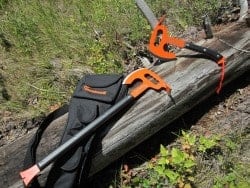
The Tactical Timahawk has a six inch curved cutting blade that chops, slices, and dices like any good battleaxe. A two-inch adz blade runs perpendicular to the grip and primary blade. An adz is a carving tool that dates back to the stone age. It also happens to be a formidable digging and breaching tool, but I doubt there was much to breach 8700 years ago, let alone structures to breach into.
My experience with an adz, or adze as Tim likes to spell it (both are correct), comes from mountaineering and ice climbing. Today the adz is a working tool for digging and carving when things are calm.
A Little Side Note
For those with forestry bends, an overgrown adz is found on the famous Pulaski Tool named after the great Edward Crockett “Ed” Pulaski who is a US Forest Service Ranger credited with saving all but five of his 45-man team during the Great Idaho Fire of 1910.
Taking no crap, Pulaski held his men face down in a mine tunnel at gunpoint until the fire passed. Five souls and two horses were lost, but it was a major credit to Polaski to restrain panic while applying his knowledge and science of forest fires.
The “Pulaski Tunnel” still exists and is listed on the Registry of Historic Places for those who would like to vacation into my neck of the woods but over in Idaho just a few clicks west of my bug out usual stomping ground. And as far as Pulaski tools go, yes I have one as does anyone else around here who dabbles with living off the land.
A Blunt Butt
The far end of the Tactical Timahawkcontains a pointed butt with a sharpness angle of 70 degrees. The unhoned 5/16” thick steel is a blunt instrument at best.
But blunt is exactly the personality you want when you need to call to action the base of the Tactical Timahawk. And given the grip and handle of the Tactical Timahawk for just such a butt-end announcement, there is little to argue about when push comes to breach.
Pack Some Gloves
Barehanded the 5/16” steel fights both directions so wearing a glove is a good idea. However, if you are in a life or death situation, a comfortable grip is for sissies. The same holds true for the punching grip of the bearded main Timahawk blade.
Bug Out Loadout
The never ending quest for the perfect bug out loadout just got easier. The Tactical Timahawk, at only three-and-a-half inches more than a foot makes for a serious contender for title of best bug out battle axe.
Also Read: 2o Things You Need In Your Get Home Bag
One of Tim Ralston’s missions in life is to combine multiple tools in one. The Tactical Timahawk is brought to you by the creator of the Crovel (crowbar and shovel), a Nax (knife + axe), the X-Caliber (multi-caliber gun), and many others from firearms to aggressive tools to watches. So the Tactical Timahawk was a natural progression, and tip of the survival iceberg, so to speak. Or perhaps the tip of the survival spear.
Real World
Using trees as aggressors, the Tactical Timahawk put a serious dent into any and all foes that got too close to me. It removed limbs, gouged holes, and punched debilitating slices into any bark that invaded my space.
The battleaxe is an evolved tool that provides both offensive and defensive aggression. When on the attack, the Tactical Timahawk force multiplies through mass, sharpness, and blade size. Rolston even sells the Tactical Timahawk as something you can throw.
Throwing
As one who has spent much time throwing conventional metal tomahawks, I’m not sure I could find the balance of the Tactical Timahawk without practice so if you intend on using Tactical Timahawk as a projectile, practice first since the disproportionately shaped head will throw off (pun intended) your usual rotation, and the adz is not much of a sticker. But at three times the blade size than a regular “hawk” you will have more rotation angle to consider a successful hit.
Related: 10 Tips For When You Get Lost In The Woods
Adz Continued
The adz is a two-inch horizontal blade that runs perpendicular to the main blade. Adzes are great at carving, precision chopping, and digging. In winter, the adz on an ice axe is used to chop steps, carve ice ledges, and flatten the tent space.
Opposite the adz on an ice axe is a pick used to support weight or arrest a fall. But it should be obvious that the pick has little use during a bug out except for those who also pack zombie fantasies in their BOB.
As a digging tool the Tactical Timahawk lacks the volume to make a major dent in soil anytime soon, but if that soil is filled with rocks and debris, the Tactical Timahawk’s adz garners the same advantage the made the Pulaski tool rock the fire lines.
Scales
The scales (handle covers) on the Tactical Timahawk are recycled plastic. They are too smooth for my taste but that is easily remedied with a little rough sandpaper. I also added a paracord lanyard through the thankfully included quarter-inch hole in the base.
Blade Cover
Something included on the larger Timahawk but not on this one is blade cover. When the Tactical Timahawk is waiting for use, like an angry rattlesnake or a bored kitten, it’s six-inch blade sits ready to attack anything that comes close to it.
So a leather or Kydex sheath would be a welcome feature. And a place to start designing would be to pay attention to Pulanski covers which have endured years of trial and abuse. My Pulaski has a simple vertical/horizontal strap that covers the blades with mundane effectiveness.
Timahawk Beard
The Tactical Timahawk’s beard has functions beyond those of the fighting kind. The balance point on the Tactical Timahawk’s handle is at the lowest point of the beard. This means the Tactical Timahawk will hang just fine on its beard hook. Whether on branch or rope, the Tactical Timahawk will grab on to anything that fits in the one-and-a-quarter inch channel between handle and blade with little chance of falling off.
Conclusion
The Tactical Timahawk aggressively attacks the single handtool space in the bug out bag. Classic hatchets like the Estwing and my favorite, the Gransfors Bruks, provide an effective bushcraft-level tool, but fall short when addressing the downside of mankind. For those darker events, tools such as the Tactical Timahawk are the best option. Maybe the only option.
Photos By:
Doc Montana


